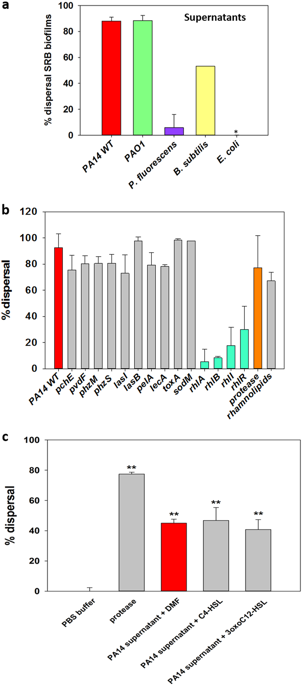npj Biofilms and Microbiomes ( IF 7.8 ) Pub Date : 2018-10-03 , DOI: 10.1038/s41522-018-0066-1 Thammajun L. Wood , Ting Gong , Lei Zhu , James Miller , Daniel S. Miller , Bei Yin , Thomas K. Wood

|
Biofilm formation is an important problem for many industries. Desulfovibrio vulgaris is the representative sulfate-reducing bacterium (SRB) which causes metal corrosion in oil wells and drilling equipment, and the corrosion is related to its biofilm formation. Biofilms are extremely difficult to remove since the cells are cemented in a polymer matrix. In an effort to eliminate SRB biofilms, we examined the ability of supernatants from Pseudomonas aeruginosa PA14 to disperse SRB biofilms. We found that the P. aeruginosa supernatants dispersed more than 98% of the biofilm. To determine the biochemical basis of this SRB biofilm dispersal, we examined a series of P. aeruginosa mutants and found that mutants rhlA, rhlB, rhlI, and rhlR, defective in rhamnolipids production, had significantly reduced levels of SRB biofilm dispersal. Corroborating these results, purified rhamnolipids dispersed SRB biofilms, and rhamnolipids were detected in the P. aeruginosa supernatants. Hence, P. aeruginosa supernatants disperse SRB biofilms via rhamnolipids. To determine the genetic basis of how the P. aeruginosa supernatants disperse SRB biofilms, a whole transcriptomic analysis was conducted (RNA-seq); based on this analysis, we identified four proteins (DVUA0018, DVUA0034, DVUA0066, and DVUA0084) of the D. vulgaris megaplasmid that influence biofilm formation, with production of DVUA0066 (a putative phospholipase) reducing biofilm formation 5.6-fold. In addition, the supernatants of P. aeruginosa dispersed the SRB biofilms more readily than protease in M9 glucose minimum medium and were also effective against biofilms of Escherichia coli and Staphylococcus aureus.
中文翻译:

铜绿假单胞菌的鼠李糖脂分散了硫酸盐还原菌的生物膜
生物膜形成是许多行业的重要问题。脱硫弧菌是代表性的硫酸盐还原菌(SRB),可引起油井和钻井设备中的金属腐蚀,腐蚀与其生物膜形成有关。由于细胞被粘在聚合物基质中,生物膜极难去除。为了消除SRB生物膜,我们检查了铜绿假单胞菌PA14上清液分散SRB生物膜的能力。我们发现,P。铜绿上清液分散了超过98%的生物膜。为了确定这个SRB生物膜扩散的生化基础上,我们研究了一系列的P。铜绿突变体,发现鼠李糖脂生产有缺陷的突变体rhlA,rhlB,rhlI和rhlR具有显着降低的SRB生物膜分散水平。证实了这些结果,纯化的鼠李糖脂分散了SRB生物膜,并且在P中检测到了鼠李糖脂。铜绿上清液。因此,P。铜绿上清液通过鼠李糖脂分散SRB生物膜。确定P的遗传基础。铜绿上清液分散SRB生物膜,进行整个转录组分析(RNA-seq);基于此分析,我们鉴定了D的四种蛋白质(DVUA0018,DVUA0034,DVUA0066和DVUA0084)。寻常大质粒影响生物膜的形成,DVUA0066(推定的磷脂酶)的产生使生物膜的形成减少了5.6倍。另外,P的上清液。在M9葡萄糖最低培养基中,铜绿菌比蛋白酶更容易分散SRB生物膜,并且对大肠杆菌和金黄色葡萄球菌的生物膜也有效。











































 京公网安备 11010802027423号
京公网安备 11010802027423号